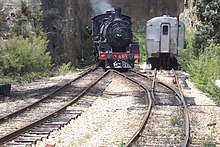Zig Zag Railway
The Zig Zag Railway was a double hairpin in the course of the crossing of the Blue Mountains by the standard-gauge Trans - Australian Railway . Today this section of the route is operated as a museum railway.
history
The hairpin had been part of the trans-Australian railroad since 1870. It is located in Lithgow in New South Wales , Australia , where the route from Sydney descends again down the Blue Mountains on its western flank.
A hairpin, the Lapstone Zig Zag, in the area of Glenbrook , with a gradient of 1:30 to 1:33 (about 3 to 3.3 percent), which was opened in 1867, was already required on the eastern ascent into the mountains . At this point, the route could still be guided along the contours of the terrain with relatively little earthwork.
In contrast, the large double hairpin at Lithgow, which was built between 1866 and 1869, required a significantly greater technical effort. The engineer responsible, John Whitton , had originally planned a three-kilometer tunnel at this point. But that was beyond the financial possibilities at the time. The Zig Zag Railway required three large brick stone bridges with 10 meter arches, four large cuts and a short tunnel.
Overall, the path between the apex and Lithgow has to overcome almost 170 m, with a gradient of 1:42 (about 2.38 percent). In the middle section of the double hairpin, it overcomes a height difference of 31 m.
The opening took place on October 19, 1869. In 1910, the facility was replaced by a double-track line with ten tunnels and an incline of 1:90, because operationally it represented a bottleneck and could no longer cope with the growing traffic. This new line is still part of the transcontinental rail link Sydney - Perth .
The museum train
The route remained without traffic for 65 years and served as a hiking trail. In 1975 the decision was made to rebuild it as a museum railway - but for cost reasons in Cape gauge with 1067 mm gauge. The vehicles for the operation therefore come from Queensland and South Australia .
The reconstruction takes place in the following stages:
- from bottom points (depot) to top points
- from top points to the original vertex of the route
- from the apex of the route to Newnes Junction (planned)
The museum railway was operated as the Zig Zag Steam and Diesel Tourist Railway . On April 1, 2011, there was a collision between a road- rail vehicle and a QR Series 2000 diesel multiple unit in which three people were injured. Due to various safety deficiencies, the operation of the locomotive-hauled trains was discontinued in December 2011 and that with diesel multiple units on June 17, 2012. Operations were scheduled to resume in mid-2013, but vehicles, buildings and telecommunications equipment were destroyed by a bush fire in October of the same year, followed by damage to the tracks from floods. According to the Facebook page of the railway, the reconstruction work was under way in autumn 2015. A new date for the start of operations has not been announced.
meaning
In a report prepared for UNESCO , consideration was given to adding this technical cultural monument to the list of World Heritage of Humanity.
Individual evidence
- ↑ Collision between Hi-Rail and Rail Motor, Zig Zag Railway, Clarence: April 1, 2011. (PDF; 1.5 MB) Rail Safety Investigation Report. Office of Transport Safety Investigations, 2011, accessed January 24, 2013 .
- ^ Zig Zag Railway - Project Restart. Retrieved January 24, 2013 .
- ^ Fire tears through iconic Zig Zag Railway. In: The Sydney Morning Herald. Retrieved February 8, 2016 .
- ^ Anthony Coulls, Railways as World Heritage Sites = Occasional Papers for the World Heritage Convention, ed .: International Council on Monuments and Sites (ICOMOS), Paris 1999, p. 15
literature
- James Bentley: The Lithgow Zig Zag . Robert Brown & Ass, Baranda, Australia 1992, ISBN 1-86273-062-8
- Phil Belbin, David Burke: Full Steam Across The Mountains . Methuen, Australia, 1981
- William A. Bayley: Blue Mountains Railways . Locomotion Productions, 1980
Web links
Coordinates: 33 ° 28 ′ 18 ″ S , 150 ° 11 ′ 39 ″ E

